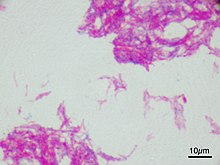Bovine tuberculosis
| Mycobacterium bovis | |
|---|---|
 |
|
| Attenuated strain of M. bovis used in the Bacillus Calmette-Guérin vaccine | |
| Scientific classification | |
| Kingdom: | Bacteria |
| Phylum: | Actinobacteria |
| Order: | Actinomycetales |
| Suborder: | Corynebacterineae |
| Family: | Mycobacteriaceae |
| Genus: | Mycobacterium |
| Species: | M. bovis |
| Binomial name | |
|
Mycobacterium bovis Karlson & Lessel 1970,ATCC 19210 |
|
Mycobacterium bovis (M. bovis) is a slow-growing (16- to 20-hour generation time) aerobic bacterium and the causative agent of tuberculosis in cattle (known as bovine TB). It is related to Mycobacterium tuberculosis—the bacterium which causes tuberculosis in humans—M. bovis, and can jump the species barrier and cause tuberculosis in humans and other mammals.
During the first half of the 20th century, M. bovis is estimated to have been responsible for more losses among farm animals than all other infectious diseases combined. Infection occurs if the bacterium is ingested.
M. bovis is usually transmitted to humans by consuming raw, infected cows milk, although it can also spread via aerosol droplets. Actual infections in humans are nowadays rare in developed countries, mainly because pasteurisation kills M. bovis bacteria in infected milk. In the UK, cattle are tested for the disease as part of an eradication program and culled if they test positive. Such cattle can still enter the human food chain but only after a government veterinary surgeon has inspected the carcass and certified that it is fit for human consumption. However, in areas of the developing world where pasteurisation is not routine, M. bovis is a relatively common cause of human tuberculosis.
Bovine TB is a chronic infectious disease which affects a broad range of mammalian hosts, including humans, cattle, deer, llamas, pigs, domestic cats, wild carnivores (foxes, coyotes) and omnivores (common brushtail possum, mustelids and rodents); it rarely affects equids or sheep. The disease can be transmitted in several ways; for example, it can be spread in exhaled air, sputum, urine, faeces and pus, so the disease can be transmitted by direct contact, contact with the excreta of an infected animal, or inhalation of aerosols, depending on the species involved.
...
Wikipedia
